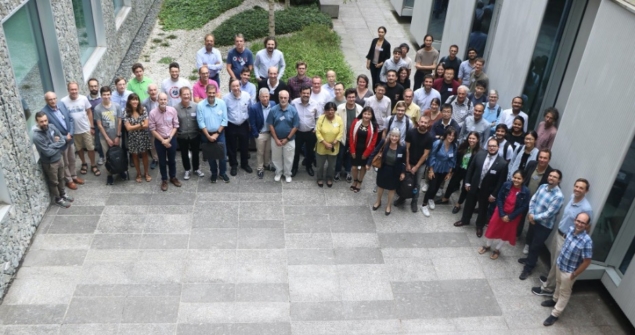
The 12th Higgs Hunting workshop, which took place in Paris and Orsay from 12 to14 September, presented an overview of recent and new results in Higgs-boson physics. The results painted an increasingly detailed picture of Higgs-boson properties, thanks to the many analyses now reporting results based on the full LHC Run 2 dataset, with an integrated luminosity of about 140 fb-1. Searches for phenomena beyond the Standard Model (BSM) were also presented.
Highlights included new results from CMS on decays of Higgs bosons to b quarks and to invisible final states, and a new limit from ATLAS on lepton-flavour violating decays of the Higgs boson. Events with two Higgs bosons in the final state were used to set limits on interactions involving three Higgs bosons and between two Higgs bosons and two weak vector bosons. All the results remain compatible with Standard Model expectations, except for a small number of intriguing tensions in some BSM searches, such as small excesses in a search for heavier partners of the Higgs boson decaying to W-boson pairs and in a search for resonances produced alongside a Z boson and decaying to a pair of Higgs bosons. These deviations from theory will be followed up by ATLAS and CMS in further analyses using Run 2 and Run 3 data.
This year’s workshop was special as the event marked the tenth anniversary of the Higgs-boson discovery in 2012. Two historical talks given by the former ATLAS and CMS spokespersons Peter Jenni (University of Freiburg & CERN) and Jim Virdee (Imperial College) highlighted the long-term efforts that laid the foundation for the Higgs-boson discovery in 2012.
The workshop also hosted an in-depth discussion on future accelerators and related detector R&D. It focused on future efforts in Europe, the US and Latin America, and featured presentations by Karl Jakobs (University of Freiburg and chair of the European Committee for Future Accelerators), Meenashi Narain (Brwon University and convener of the energy frontier group of the Snowmass process), Maria-Teresa Tova (National University of La Plata) and representative for the Latin American strategy effort) and Emmanuel Perez (CERN), who discussed recent improvements in physics analyses at future colliders.
Recent theory developments were also extensively covered, in particular recent developments in higher-order computations by Michael Spira (PSI), which highlighted the agreement between experimental results and predictions. A review of recent theory progress towards future colliders was also presented by Gauthier Durieux (CERN), while Carlos Wagner (Enrico Fermi Institute, & Kavli Institute for Cosmological Physics) discussed the new-physics that can be explored via precise measurements of Higgs-boson couplings. Finally, a “vision” presentation by Marcela Carena (Fermilab) highlighted new opportunities for the study of electroweak baryogenesis in relation to Higgs-boson measurements.
Many experimental sessions were held regarding recent results on a wide variety of topics, some which will be relevant in upcoming Run 3 measurements. This includes measurements related to potential CP-violating effects in the Higgs sector, as well as effective field theories (EFTs). This latter topic allows a general description of deviations from Standard Model predictions in Higgs-boson measurements and beyond, and much improved measurements in this direction are expected in Run 3. The search for Higgs-boson pair production was also an important focus at the Paris meeting. The latest Run 2 analyses showed greatly improved sensitivity compared to earlier rounds, and further improvements are expected in Run 3. While sensitivity to the Standard Model signal is not expected until the High-Luminosity LHC, these searches should set strong constraints on BSM effects in the Higgs sector.
Concluding talks were given by Fabio Maltoni (Louvain) and Giacinto Piacquadio (Stony Brook), and the next Higgs Hunting workshop will be held in Orsay and Paris from 11 to 13 September 2023.







